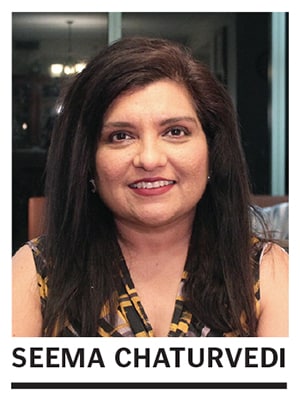Women in the workforce: It's time to act bold
While it is heartening to see emphasis on new women hires, the reality is that most of them are still at a junior level or in support functions, Seema Chaturvedi, author and managing partner, AWE Fund


 My career choices of the past 25-plus years have been guided by the need to create value. Whether it was managing and underwriting large public issues or being a wealth manager or being an advisor to owners of mid-market companies seeking to maximise shareholder value or professionally investing in private and public equities, I was always intrigued by where I could find the untapped or under-tapped value. And my evolution to a founder of a venture fund builds upon this same streak.
My career choices of the past 25-plus years have been guided by the need to create value. Whether it was managing and underwriting large public issues or being a wealth manager or being an advisor to owners of mid-market companies seeking to maximise shareholder value or professionally investing in private and public equities, I was always intrigued by where I could find the untapped or under-tapped value. And my evolution to a founder of a venture fund builds upon this same streak.
The one aspect, though, common in all my career choices is that I was often one of the very few women pursuing that specific career option. Most investment banking and institutional investing was, and still is, very male-dominated. Sign of the times? Maybe. But that did not stop me from participating in these vocations. Truth be told, I never paid attention to the significant gender inequity in the investor world.
But now I do, and I do recognise the importance of being a female founder of a venture fund, not just for the value I create for our investors but also for the broader economy as well. And I don’t take this responsibility lightly.
I do get asked what it means to be a woman in a predominantly male-dominated industry. Less than 10 percent of female fund managers are women. Less than 10 percent of global wealth is being managed by women while women own nearly 60 percent of global wealth. These numbers do perplex me especially given that most women-led fund managers outperform. A recent Goldman Sachs study supports this assertion with empirical data.
To say I was ‘woke’ to the prevailing gender inequity in the fund management industry would be a falsehood. Till about as recently as 2015, I had my blinders on. And these blinders firmly kept me in the lane, focussed on delivering for my investors. Did I complain when I saw opportunities not being made available to me that were offered to some of my other male colleagues? Absolutely. Did I ever think of that as a manifestation of gender bias? No.
All that changed when I founded and led a programme for promoting women entrepreneurs in India—Project All India Roadshow for Women’s Economic Empowerment through Entrepreneurship (AIRSWEEE). This US State Department-funded programme sensitised me to the gross inequity in accessing venture equity—less than 2 percent of venture funding going to women businesses.
Like every astute entrepreneur and investor, I followed the path to where the problem was. Because solving for that problem could unleash value. It was no coincidence then that I discovered that less than 10 percent of fund managers making those investment decisions are women. Fund managers at a decision-making partner level are even fewer.
This is a significant bottleneck which is contributing to why women receive such a paltry amount of venture funding when there are such low levels of allocators of capital who are women. It is human psychology to invest in what you are most comfortable and familiar with when one tries to derisk investments. At an eary stage, if most decision-makers are men, they will most likely invest in men-driven companies. This hypothesis is actually supported by empirical evidence.
Estimations are it will take over 150 years to achieve gender equity. While allocation of capital can significantly accelerate this, the bottleneck at the fund manager level is real, especially at the partner or decision-maker level.
While it is heartening to see the emphasis on new women hires by some established fund platforms, the reality is that most of those hires are still at a junior level or in support functions. The number of women at partner-level positions in the VC industry is still rather modest.
So what is it like to be one of the few women founders of a new standalone fund platform in the VC industry? It has been an interesting ride.
As a woman VC, I get approached by many women founders who tell me they are relieved that I understand them that I have walked the same path as them and truly understand how they too can and will create value for their investors. This has been a very fulfilling part of the journey.
This does not bode well for breaking this massive glass ceiling. How do we change this?
There are new support groups that have come up promoting women investors, such as Women in Investing, 2x Ignite and WinPE. But this is not moving the needle just yet at the decision-maker, partner level, at the pace needed.
I would like to propose that the regulators and policymakers step in to make this a priority focus area. This requires bold action which can be led very ably by the doyens of the development agenda, specifically the Development Finance Institutions. They can be ably supported by the significant pools of capital such as pension funds and endowment funds. I would even be bold enough to recommend that a certain amount of these assets under management be earmarked for female-led fund managers who specifically have a gender-smart investment thesis.
Such a proactive policy will definitely unleash the significant multiplier effect that investing in gender equity can truly deliver. It will create a multi-generational, gender equitable, climate positive economic development impact which is the bedrock of sustainable nation building.
The author is founder & managing partner of AWE Funds, an early-stage venture equity fund investing in innovation to promote gender equity and climate action
First Published: Nov 17, 2022, 17:30
Subscribe Now